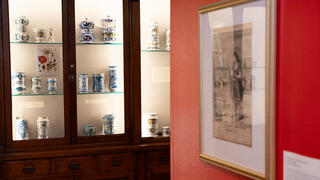
On View: Selections from the Philadelphia College of Pharmacy Permanent Collection
Location: Museum Gallery, Griffith Hall First Floor (gallery map)
On view July through December 2024
Exhibition sections:
Material History from the Philadelphia College of Pharmacy
Artifacts and ephemera showcasing institutional history and student life at the college, including a special selection from the life and work of William Procter Jr.
Pharmacy Practice
History and modernity blend to offer an enlightening journey through the evolution of pharmacy care.
Includes fall 2023 student interns Dee Feuda and Deryn Bullock’s co-curated display on sex and gender in pharmacy products and spring 2024 student intern Maximus Fisher’s independent project, “Prescribing Trust,” an installation exploring the social contract between patients and pharmaceutical professionals within the evolving legal and cultural landscape of pharmaceutical advertising.
“Philadelphiana”
Highlights from Philadelphia's history of independent pharmacy practice and pharmaceutical manufacturing, illustrating the evolution from small-scale operations to corporate production.
Compounding & Manufacture
Tools and techniques of pharmaceutical production from pre-industrial practices to the present. Includes spring 2024 student intern Katherine Field’s independent project: “What is Drug Compounding? Selections from a Mallinckrodt Chemical Compounding Set,” fall 2022 student intern Sophie Vo’s display of pre-industrial pill-making hand tools, lantern slides showing early 20th century Pfizer and Lilly factories, and selections from the Alan Strauss global mortar and pestle collection.
Pharmacy Education
Lab samples and student notebooks bridge theory with hands-on experience.
Includes a selection of artifacts and ephemera from Joseph P. Remington’s (1847-1918) tenure at the Philadelphia College of Pharmacy, an extensive collection of traditional Chinese medicine cabinet specimens given to the PCPS Practice Department from Philadelphia’s Drueding brothers, and spring 2023 student intern Tanner Lamoreaux’s independent project on pharmacy education outside the university in the 19th and 20th centuries.
Natural Medicine
Botanicals, minerals, and other naturally-derived therapeutics used in healing practices and drug development across the globe. Includes a display on Ayurveda, one of the world's oldest holistic healing systems, as well as botanical specimens from the private collections of renowned botanist and pharmacist John M. Maisch and distinguished pharmacist and scholar Edson S. Bastin, both professors of materia medica at the Philadelphia College of Pharmacy in the late 1800s.
Decorative Arts in Apothecary
European apothecary jars and albarelli, dating back to the 16th century offer insight into the utilization of herbs and substances in ancient medicine, while the series of Burroughs Wellcome Co. Delft tiles commissioned in the 1970s also on view demonstrate the prevailing power of apothecary iconography.

Herbs of Heritage: Ethnobotany in Irish Folklore
The Marvin Samson Museum for the History of Pharmacy invites you to delve into the rich history of traditional Irish folk medicine. Featuring a selection of botanical specimens from the Museum collection alongside archival reproductions from the National Folklore Collection of Ireland, the display offers a glimpse of cures and remedies that have been passed down through generations in rural Ireland.
Established in 1935 by the Irish Folklore Commission, the National Folklore Collection is one of the world's largest folklore repositories. It captures Ireland's oral traditions, customs, and beliefs through a rich compilation of manuscripts, audio recordings, and photographs collected by folklorists, teachers, and students. The hand-written archival reproductions displayed here discuss remedies, cures, and healing properties attributed to various plants in rural Irish healing traditions. Some of these practices have even been scientifically validated, demonstrating the wisdom inherent in folk medicine.
The selection of newspaper reproductions also on display speaks to the intriguing intersection between rural Irish folk medicine and fairy folklore, in which sudden or unexplained illnesses and deformities were often attributed to fairy afflictions. Up until the 21st century, it was a common belief that fairies abducted humans, leaving behind a 'changeling,' or fairy substitute. People often resorted to using potent, and sometimes poisonous, plants to banish the changeling and cure the afflicted. The stories told in these newspaper archives document instances of real-life individuals who turned to these drastic ‘cures,’ often with fatal results. These historical accounts, viewed through the lens of modern medical knowledge, reveal a deep misunderstanding of conditions now recognized as medical ailments. An empathetic reading of these narratives grounded in an understanding of the state of medical knowledge and cultural beliefs of the time is crucial.
By presenting this nuanced narrative, "Herbs in Heritage: Ethnobotany in Irish Folklore" showcases the interdisciplinary nature of traditional medicine. It bridges the gap between ethnobotany, folklore, and medical history, offering a comprehensive understanding of how health and disease were perceived and treated in rural Ireland.
On view July through December 2024.






